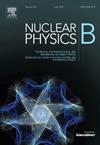大黄蜂引力中的奇异夸克星和冷凝暗星
IF 2.8
3区 物理与天体物理
Q2 PHYSICS, PARTICLES & FIELDS
引用次数: 0
摘要
在本文中,我们在最小标准模型扩展的框架内研究了由各向同性物质组成的相对论性恒星的性质,其中大黄蜂场(BF)与时空耦合导致自发洛伦兹对称破断。我们采用解析状态方程来描述冷凝暗星或奇异夸克星。对结构方程进行了数值求解,并计算了质量-半径关系。详细研究了大黄蜂参数l的影响,并利用大质量脉冲星(PSR) J0740+6620和奇光高能立体系统(HESS) J1731-347致密天体得到了一个上限。本文章由计算机程序翻译,如有差异,请以英文原文为准。
Strange quark stars and condensate dark stars in Bumblebee gravity
In this paper, we investigate the properties of relativistic stars made of isotropic matter within the framework of the minimal Standard Model Extension, where a Bumblebee field (BF) coupled to spacetime induces spontaneous Lorentz symmetry breaking. We adopt analytic equations-of-state describing either condensate dark stars or strange quark stars. We solve the structure equations numerically, and we compute the mass-to-radius relationships. The influence of the Bumblebee parameter l is examined in detail, and an upper bound is obtained using the massive pulsar (PSR) J0740+6620 and the strangely light High Energy Stereoscopic System (HESS) J1731-347 compact object.
求助全文
通过发布文献求助,成功后即可免费获取论文全文。
去求助
来源期刊

Nuclear Physics B
物理-物理:粒子与场物理
CiteScore
5.50
自引率
7.10%
发文量
302
审稿时长
1 months
期刊介绍:
Nuclear Physics B focuses on the domain of high energy physics, quantum field theory, statistical systems, and mathematical physics, and includes four main sections: high energy physics - phenomenology, high energy physics - theory, high energy physics - experiment, and quantum field theory, statistical systems, and mathematical physics. The emphasis is on original research papers (Frontiers Articles or Full Length Articles), but Review Articles are also welcome.
 求助内容:
求助内容: 应助结果提醒方式:
应助结果提醒方式:


